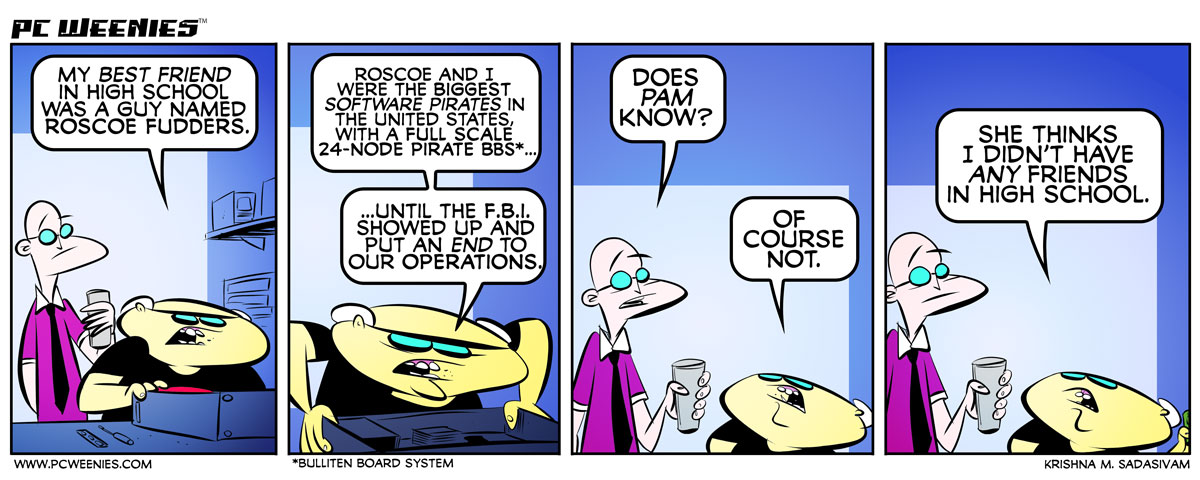Reminiscing about Roscoe
Bulliten Board Systems (BBS’s) were my first introduction to being “online”. I still remember the days of dial-up, and the whistles and static of a 2400 baud modem attempting to connect. The popular BBS’s would have multiple nodes to handle multiple incoming connections. It was slow and crude by today’s standards, but it was exciting as heck for me at the time. I often think about the good old days of BBS’s. I miss the vibrant and electic community, the nerdy discussions, but mostly I miss how civil people were on many of the forums I frequented. Best of all, I remember a time where there was no spam. What do you fondly remember about those days?
-Krishna





Sixpack
April 28, 2016 at 4:01 amHi Krishna
it’s Bulletin not Bulliten Board system ;-)
Andreas
Krishna
April 28, 2016 at 6:02 amGood catch! Thanks, Andreas!
Thomas
April 28, 2016 at 8:57 amSome of the very few “good ol’ times”, that really were “good od’ times”!
YESS! 600 baud, 2400 baud Lightspeed modem, 9600 baud and already a more or less graphical internet.
BBS, Mailboxes, the fight for a connection – always 1 to 1, server with 5 1/4 ” disks, carrying the mailbox system, worn thin in the middle.
We did great things, we learned, we taught, we discussed and yes, we were far more interested in content and result than in being right,
Sure, the first flame wars were from that era, but it still was about content, OS wars et al.
Today, I see hate, envy and an immense rise of people presenting themselves ignorant, uneducated and clueless, while whining, bitching, hating and commenting on everything.
I don’t want 2400 baud back, but some of the good spirit of these times.
Thomas
Matt
April 28, 2016 at 11:10 amI remember being able to make a good dent in my morning Americano while waiting for the modem to connect. Most people found the static grating, but I enjoyed those moments…a chance to relax for a moment, slowly sipping my coffee.
Bob Harvey
April 28, 2016 at 11:28 amFrom 1990-1994 there were two main categories of BBS’s that I enjoyed: the first were the user group club BBS’s, which served as online message (private email), group announcement and file storage boards. The second type were “island” BBS’s, dial-up enclaves promoted by their system operators or “sysops,” sometimes with small fees, but often gratis.
Millions of people worldwide were frequenting BBS’s, with various purposes and relationships.
Our Macintosh User Group BBS provided a reliable nexus for sending instant emails to fellow club members, as well a repository of downloadable computer utilities and shareware. When modems graduated from the plodding 2400 to 9600 bps, touring the BBS universe was fast-tracked.
The island BBS’s often became intensely popular due to their social aspect. People wanted to connect from home without braving the risks and expenses of traffic, just as they do now with email, Facebook, Twitter, and other social media. BBS’s had a finite number of dial-up nodes, so most of them limited their users to a quota of 15-30 minutes per day to assure best shared use of their resources. Many BBS’s had primitive online games and contests, and the winners were rewarded with an increase in their minute quota, allowing them to download greater quantities of file.
In fact one BBS I frequented had a gimmick: when you signed off, your screen became a text-graphic of a slot machine. You watched it “roll” its wheels, and then you might win a few extra minutes for your next dial-up.
The trade magazines of that era had pages of lists of local dial-up BBS. They were categorized as free or $ fee, and also as to their connection speed capacities. U.S. Robotics developed the first reliable 9,600 bps modems, but they used what became a proprietary HST protocol. Still, that protocol was widely employed, because folks craved the 4x speed compared to the prevailing 2,400 bps.
HST soon managed speeds of 14,400 bps, a whopping 50% increase over 9,600, but a full six times as fast as the 2,400.
So BBS’s helped drive advances in modem technology.
Soon non-HST modems were increasing their connection capacities and increased their rates through the historical progression from 9,600/14,400/16,800/19,200/21,600 etc to 33,600. The ITU was a central technology sanctioning body bringing standards of interoperability, thus allowing allowing most manufacturers to interconnect their modems.
Eventually the top practical analog modem speed was standardized with the ITU V.92 protocol, and 56 kbps speeds were theoretically feasible. To me it was thrilling to detect my modem had linked with a BBS at 50+ kbps, although that was a rarity.
Due to phone line noise and distance from the telco central office, a connection of 46-48 kbps was the highest routinely practical link speed.
Even if I had no account or purpose in signing into a BBS, I enjoyed dialing various BBS’s just to verify what speed my modems would achieve. It reminded me of seeing speedometers on my cars exceeding 120 mph for the first time. http://garbell.com/racing/speedo133.jpg
The end of the BBS era was hastened by the evolution to dial-up Internet Service Providers (ISP’s). In 1994, for the first time, any person with a computer and even a lowly 2,400 bps modem could for a monthly fee of about $20-$25 connect to and become a full peer on the internet, often with unlimited monthly minutes.
The Mosaic web browser, absurdly primitive compared to today’s browsers, still was the key utility hastening the switch from BBS’s to true internet presence.
Carl
April 28, 2016 at 7:58 pmI started with a 2400 bps internal modem in my IIgs, eventually working up to the v.92 modem, external I used on my first ISP, one started by people I knew from the BBS world. Finally got an Ethernet card and connected to a cable modem. Then I got my first Mac, a G3 Powerbook, and router. I still have that v.92 modem gathering dust. Now we have 2 iMacs, a Macbook Pro, iPhones and an iPad. Still have the IIgs, but seldom turn it on, preferring to emulate on the iMac. I still get together with other retrocomputing enthusiasts at KansasFest every Summer. http://www.kansasfest.org
Elf
June 29, 2016 at 1:14 amThe Wrong Number BBS 209.943.1880 in Stockton, CA … I can still whistle the number and the SysOp is still one of my best friends 30 years later and most of the old core users still stay on touch. It ran PCBoard, 4 POTs, and we had a FidoNet connection.
Yes, I miss those days and am proudly one of the crazys that can tell you the connection speed AND level of encryption.
Bonus, one of the “community UNIX machines I’m on has YModem and ZModem as DL options if you come in on one of the modems instead of through The Net.
Cheers, and thanks for the laugh/a good walk down memory lane.
Elf
June 29, 2016 at 1:16 amEdit For Above: encryption should be compression. See what thirty years has done to overcook the noodle?